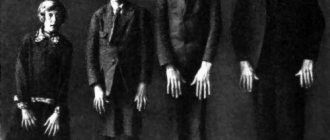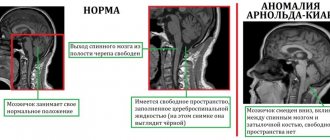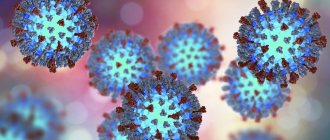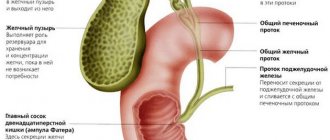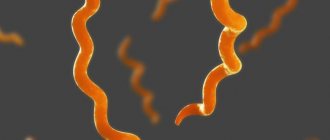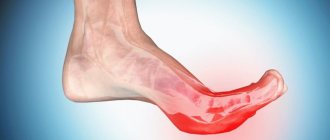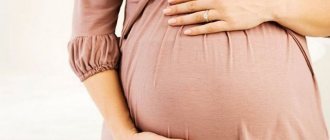Obstetrician-gynecologist, candidate of medical sciences. Area of professional interests: management of pregnancy and the postpartum period, correction of their complications; diagnosis and treatment of any gynecological diseases, as well as subsequent rehabilitation; minor gynecological operations.
Author: Rebenok.online · Published 03/27/2017 · Updated 02/14/2019
The main period in
menstrual cycle is the ovulatory phase. It is characterized by the release of an egg. During this period, the fertility of the fair sex reaches its peak.
OVULATION AND TIME OF FERTILIZATION
OVULATION (from Latin ovum - egg) - the release of a mature egg capable of fertilization from the ovarian follicle into the abdominal cavity; stage of the menstrual cycle (ovarian cycle). Ovulation in women of childbearing age occurs periodically (every 21-35 days). The frequency of ovulation is regulated by neurohumoral mechanisms, mainly by gonadotropic hormones of the anterior pituitary gland and ovarian follicular hormone. Ovulation is promoted by the accumulation of follicular fluid and the thinning of the ovarian tissue located above the protruding pole of the follicle. of ovulation, which is constant for every woman, undergoes changes within 3 months after an abortion, within a year after childbirth, and also after 40 years, when the body prepares for the premenopausal period. Ovulation stops with the onset of pregnancy and after the cessation of menstrual function. Establishing the date of ovulation is important when choosing the most effective time for fertilization, artificial insemination and in vitro fertilization.
What is this?
The proper functioning of the female body implies the cyclical nature of all processes. Each phase of the menstrual cycle is characterized by a set of certain signs. Any deviation entails other violations. Ultimately, they make it impossible to get pregnant.
The growth of follicles and endometrium occurs in the follicular stage. The ovulatory phase in women is characterized by the release of an egg from the follicle. A healthy woman has up to 12 full ovulations per year. In their absence, conception becomes impossible.
The vital activity of the egg can reach 48 hours. In rare cases, it is 2–3 hours. During this period, the sperm must have time to fertilize it. The success of conception in this case depends on the spermogram and the date of sexual intercourse.
According to medical statistics , healthy sperm live in a woman’s body for up to 7 days. This confirms the fact that conception can occur if sexual intercourse occurs a week before ovulation. But most often sperm live no more than 4 days.
SIGNS OF OVULATION
Subjective signs of ovulation may include short-term pain in the lower abdomen. Objective signs of ovulation are an increase in mucous discharge from the vagina and a decrease in rectal (basal) temperature on the day of ovulation with an increase in it the next day, an increase in the content of progesterone in the blood plasma, etc. Ovulation are caused by dysfunction of the hypothalamic-pituitary-ovarian system and can be caused by inflammation genitalia, dysfunction of the adrenal cortex or thyroid gland, systemic diseases, tumors of the pituitary gland and hypothalamus, stressful situations. The absence of ovulation during childbearing age (anovulation) is manifested by a disturbance in the rhythm of menstruation such as oligomenorrhea (menstruation lasting 1-2 days), amenorrhea, and dysfunctional uterine bleeding. Lack of ovulation (anovulation) is always the cause of a woman’s infertility. Methods for restoring ovulation are determined by the cause that caused anovulation and require a visit to a gynecologist and special treatment.
How to determine?
Two categories of women are interested in determining the exact day when ovulation occurs: those who under no circumstances want to get pregnant, and those who plan to conceive as soon as possible. The latter are especially interested in the exact time of a possible miracle.
Some representatives of the fair sex note certain signs that occur regularly when they enter the phases of the ovulatory cycle. Daily discharge takes on a rusty color, due to a small discharge of blood when the follicle ruptures, slight nagging pain appears in the lower abdomen and lower back, as during menstruation. Also, some young ladies observe hormonal manifestations in the form of special abundance and consistency of discharge, the appearance of acne or other skin manifestations. In some women, the breasts become enlarged and become sensitive. Mood may also change, emotionality and tearfulness may increase. There may be an increase in libido shortly before the onset of X-day.
OVULATION AND CONTRACEPTION
Some women experience peak sexual arousal around the days of ovulation . However, the use of a physiological method of contraception from pregnancy, based on sexual abstinence during ovulation , is especially difficult for young spouses, whose frequency of sexual intercourse reaches a fairly high level. In addition, with strong love excitement and nervous stress, additional ovulation can occur (especially with episodic, irregular intercourse) and then not one, but two eggs mature in one menstrual cycle. This should be kept in mind when choosing one or another method of contraception.
Treatment
There is no specific treatment for ovulatory syndrome. Women are prescribed symptomatic therapy aimed at eliminating pain.
- Gynecologists recommend taking analgesics and antispasmodics during ovulation - “Baralgin”, “Solpadein”, “No-shpu”, “Spazmalgon”.
- To relieve pain, it is possible to use NSAIDs - Ibuprofen, Nurofen, Nise, Ketoprofen, Naproxen, Indomethacin.
- Long-term use of oral contraceptives prevents pain. They are prescribed for existing hormonal deficiency, which is the cause of vaginal discharge.
- Vitamin-mineral complexes and restoratives have a beneficial effect on the female body during ovulation.
- Physiotherapeutic methods are used in the absence of signs of acute inflammation. Warming compresses and a heating pad on the abdomen significantly reduce the intensity of pain. Warm baths using aromatic oils or medicinal plants will also help relieve pain.
- Experts recommend maintaining sexual rest during ovulation and completely eliminating physical activity.
- Traditional medicine that allows you to get rid of the manifestations of ovulatory syndrome include: baths with infusion of chamomile and cinnamon, a tampon from an infusion of calendula herb, celery juice for oral administration, an infusion of horsetail and lemon balm, an infusion of boron uterus and strawberries, an infusion of water pepper and nettle.
PHYSIOLOGY OF THE OVULATION CYCLE
As soon as every healthy girl aged 11-15 years begins to menstruate, which is an indicator of her body’s readiness for childbearing, problems arise associated with counting the days of the menstrual cycle and the legitimate question of why menstruation does not occur, or vice versa, why the long-awaited pregnancy does not occur . This forces a woman to think and wait all the time, to be in the dark about what is happening to her every month. And so every month for decades.
Forecast
The physiological anovulatory cycle in most cases is not accompanied by obvious signs for the patient, eliminates itself after the influence of the risk factor on the body ceases and does not require drug treatment. The prognosis of the disease in the presence of a pathological absence of ovulation is less favorable, but timely treatment makes it possible to ensure pregnancy in 30–40% of cases.
If menstruation is not accompanied by the release of an egg from the ovary, then after its completion, as in a normal cycle, monthly discharge still occurs. This condition can be caused by physiological and pathological reasons. In the latter case, it requires therapy, since the woman may experience complications: infertility, metrorrhagia, absence of menstruation, or the appearance on other days of bleeding similar to menstruation.
A woman’s reproductive abilities are determined by the presence of sex cells—eggs. However, the period of time when conception can occur is very short and occurs on specific days of the menstrual cycle.
DURATION OF MENSTRUATION AND CYCLE
Ideal menstruation lasts 3-5 days and repeats every 28 days. However, for some women this cycle takes 19 days or even less, while for others it lasts from 35 to 45 days, which is a feature of their body, and not a violation of menstrual function. The duration of menstruation can also vary within a week depending on the body. All this should not cause alarm in a woman, but a delay of more than two months, called opsometry, or more than six months - amenorrhea, should alert the woman and force her to find out the reason with a gynecologist.
Hormonal levels during this phase
The amount of certain hormones in the female body constantly changes depending on the phase of the cycle and controls all reproductive processes to prepare the uterus for pregnancy.
Luteinizing hormone
A powerful surge of this hormone is observed just during the period of ovulation. Its release provokes rupture of the follicle and the release of a mature egg ready for fertilization. This ovulatory phase lasts a maximum of 72 hours, and is followed by the luteal phase - this is the interval between ovulation and the next critical days.
Follicle stimulating hormone (FSH) is produced by the pituitary gland of the brain. This hormone stimulates the production of eggs by the ovaries and is actively produced at the very beginning of the cycle, starting it. This hormone also provokes the production of estrogen, another important hormone, the level of which steadily increases towards the middle of the cycle, reaches a peak before ovulation and provokes the release of luteinizing hormone.
Progesterone
Immediately after the completion of the ovulatory phase, the follicle begins to produce the hormone progesterone. It prepares the uterus and its mucous membrane for the subsequent implantation of a fertilized egg. At this time, the empty follicle continues to produce progesterone, although it decreases in size. Under the influence of this hormone, premenstrual syndrome may occur in the form of breast tenderness, bloating, emotional instability and an increased need for sleep.
Estradiol
This is an equally important hormone that is a component of estrogen. It forms the structure of the endometrium, promotes its thickening, looseness, and saturation with nutrients in order to prepare the reproductive organ for pregnancy.
Estradiol also increases at the time of ovulation and is involved in follicle rupture. But with the onset of the luteinizing phase, estradiol, in the absence of pregnancy, drops sharply, but if fertilization has occurred, the hormone does not decrease, but begins to rapidly increase in quantity.
The ovulatory phase occupies a short period of time in a woman’s menstrual cycle and, nevertheless, it is decisive. It is at this time that the egg is fertilized and, as a result, conception occurs. Ovulation is the turning point that divides the cycle into a “before” phase and an “after” phase. Knowing the exact day of the ovulatory period will help you accurately plan preparations for pregnancy or protect yourself from sexual intercourse if pregnancy is undesirable.
Ovulation occurs monthly in healthy women of childbearing age; only a few cycles without ovulation per year are considered acceptable. During this fairly short period of time, a woman has the ability to conceive a baby. On the remaining days of the cycle, in the absence of a mature germ cell, this is not possible. This article will tell you what features the ovulation period has.
DURATION OF THE MENSTRUAL CYCLE
The menstrual cycle is a complex physiological process that continues in women up to 45–55 years of age. It is regulated by the so-called reproductive centers located in the middle part of the diencephalon - the hypothalamus. The changes that occur during the menstrual cycle are most pronounced in the uterus and ovaries. In the ovary, under the influence of hormones produced by the ovarian follicles, partly by the adrenal cortex and testes, the growth and maturation of the main follicle, which contains the egg, occurs. A mature follicle ruptures and the egg, along with follicular fluid, enters the abdominal cavity and then into the uterine (fallopian) tube. The process of rupture of the follicle and the release of a mature (suitable for fertilization) egg from its cavity is called ovulation , which, with a 28-day cycle, occurs most often between the 13th and 15th days.
What is the ovulatory phase
The ovulatory phase is a period of time in the menstrual cycle, lasting on average no more than 2 days, the main action of which is the release of a mature female cell ready for fertilization from the ovary. In the classic version, with a regular 28-day cycle, this time period falls in the middle of the cycle, that is, on the 14th day.
NOTE!
Ovulation can occur much earlier or, conversely, late: just a few days before menstrual bleeding. This is due to the individual characteristics of the female body and hormonal balance.
Corpus luteum, estrogens, progesterone
At the site of the ruptured follicle, a corpus luteum forms. These morphological changes in the ovary are accompanied by the release of sex steroid hormones - estrogens and progesterone. Estrogens are secreted by the maturing follicle, and progesterone is secreted by the corpus luteum.
The release of estrogen has two maximums - during ovulation and during the period of maximum activity of the corpus luteum. So, for example, if the normal estrogen content is about 10 mcg/l, then during ovulation it is about 50 mcg/l, and during pregnancy, especially towards the end, the estrogen content in the blood increases to 70-80 mcg/l per pregnancy. due to a sharp increase in estrogen biosynthesis in the placenta.
Together with progesterone, estrogens promote implantation (introduction) of a fertilized egg, maintain pregnancy and promote childbirth. Estrogens play an important role in the regulation of many biochemical processes, participate in carbohydrate metabolism, in the distribution of lipids, and stimulate the synthesis of amino acids, nucleic acids and proteins. Estrogens promote the deposition of calcium in bone tissue, delay the release of sodium, potassium, phosphorus and water from the body, that is, they increase their concentration both in the blood and in electrolytes (urine, saliva, nasal secretions, tears) of the body.
The release of estrogen is controlled by the anterior pituitary gland and its genadotropic hormones: follicle-stimulating hormone (FSH) and luteinizing hormone (LH).
Under the influence of estrogens, in the first phase of the menstrual cycle, called follicular, regeneration occurs in the uterus, that is, the restoration and growth of its mucous membrane - the endometrium, the growth of glands that elongate and become convoluted. The mucous membrane of the uterus thickens 4-5 times. In the glands of the cervix, the secretion of mucous secretion increases, the cervical canal expands, and becomes easily passable for sperm. In the mammary glands, epithelium grows inside the milk ducts.
What are the phases of ovulation?
Ovulation is the release of an egg, which is later either fertilized by a sperm or dissolves and is released with menstrual bleeding.
The course of ovulation is determined by an increase in hormone levels during the menstrual cycle. This process includes three phases.
- Periovulatory or follicular phase. The layer of cells around the egg begins to develop and produce more mucus, or follicular fluid, which contains the hormones estrogen. The lining layer of the inner surface of the uterine wall begins to thicken under the influence of estrogens.
- Ovulatory phase. Enzymes are released that form a hole or stigma in the follicle. The egg and its surrounding cells use stigma to enter the fallopian tube. This is the period of highest fertility and usually lasts from 24 to 48 hours.
- Postovulatory or luteal phase. Luteinizing hormone is released. The fertilized egg is implanted in the uterus, and the unfertilized egg gradually stops producing hormones and disintegrates within 24 hours.
The lining layer of the inner surface of the uterine wall (endometrium) also breaks down and leaves the woman's body in the form of menstrual bleeding (menstruation) or periods.
LUTEAL PHASE
In the second phase, called the luteal phase (from the Latin word luteus - yellow), under the influence of progesterone, the intensity of metabolic processes in the body decreases. The growth of the mucous membrane of the uterine body stops, it becomes loose, swollen, a secretion appears in the glands, which creates favorable conditions for the attachment of a fertilized egg to the mucosa and the development of the embryo. The glands stop secreting mucus, and the cervical canal closes. In the mammary glands, alveoli arise from the overgrown epithelium of the end sections of the milk ducts, capable of producing and secreting milk.
If pregnancy does not occur, the corpus luteum dies, the functional layer of the endometrium is rejected, and menstruation occurs. Monthly bleeding varies from three to seven days, the amount of blood lost ranges from 40 to 150 g.
Anovulatory cycle: anovulation is the main cause of infertility
The anovulatory cycle refers to menstruation without the development of the corpus luteum while maintaining menstrual bleeding. In this case, processes of growth of the uterine mucosa are observed, and the secretory phase, which usually should occur after ovulation under the influence of the resulting corpus luteum, is absent.
Such cycles can be periodically observed even in women without any health problems, especially during the formation of the menstrual cycle in teenage girls, during breastfeeding and during menopause (decay of menstrual function). What signs and symptoms indicate this phenomenon and what treatment is offered to girls and women - read the article.
Reasons for development
In almost all healthy women of reproductive age, such phenomena are observed relatively rarely (1–3% of all cases) and can alternate with normal menstrual periods. Anovulation can be caused, for example, by climate change when moving to other geographical regions.
The most common causes (physiological) are the processes of age-related changes in the female body - puberty, as well as the decline of reproductive function (menopause or menopause).
A similar condition, as a physiological process, is characteristic of pregnancy and the period of postpartum lactation.
If rhythmic bleeding resumes in half of breastfeeding women, the cycle is also anovulatory.
It is impossible to become pregnant during an anovulatory cycle
As a pathology that requires correction, the anovulatory cycle is observed in uterine bleeding caused by disruption of follicle maturation processes, absence of the luteal phase and ovulation, and infertility.
The causes of the pathological cycle are almost always disturbances in the functioning of the hypothalamic-pituitary system, which directly controls all phases of the menstrual cycle, as well as ovarian dysfunction.
Violations of the hypothalamic-pituitary regulation are manifested in insufficient production of follicle-stimulating hormone, as a result of which the follicle cannot mature and the ovulation process does not occur, as well as insufficiency of lactotropic hormone, changes in the ratio of all sex hormones, and in rare cases, excessive production of prolactin by the pituitary gland.
The disease can be caused by inflammatory processes in the ovaries or appendages, impaired maturation of sex hormones, functional changes in the thyroid gland or adrenal cortex, infections, neuropsychiatric disorders, intoxication, vitamin deficiencies or other nutritional disorders. Often a similar condition is observed with various defects of the reproductive system, delayed sexual development, and genetic pathology.
During the course of the disease, periods of growth and reverse development of the follicle may vary in duration and nature in the ovaries.
If the cycle of its development and movement is not changed, then a rapid increase in the concentration of the hormone estrogen is observed, otherwise it increases monotonously and slowly.
The anovulatory cycle is characterized by an excess of the action of this hormone, which is not replaced by the influence of the hormone progesterone. In rare cases, a decrease in estrogen is observed.
If menstrual-like bleeding develops during the pathology, this indicates a decline in the influence of sex hormones, which is caused by a decrease in the size of the follicle.
In adolescence, when the formation of menstrual function occurs, such a cycle is caused by the lack of the required amount of luteotropic and luteinizing hormone, the synthesis of which reaches the required level only by 15–16 years. During menopause, similar changes are observed, only in the reverse order. The alternation of ovulatory and anovulatory cycles during menopause is replaced by a change in the nature of menstruation and the duration of the cycle.
The disease can be suspected based on a number of characteristic signs. Not all women subjectively notice the onset of ovulation; for some, this period proceeds almost unnoticed.
Mucous discharge that appears during ovulation, which is not infectious in nature, is quite viscous and lasts for several days. If there is no such discharge, the woman does not experience discomfort in the lower abdomen or in the area of one of the ovaries, then we can assume that the cycle is anovulatory.
In addition, the basal temperature indicator is important. Signs: constant basal temperature during the cycle, absence of its fluctuations. Uneven duration of the cycle, its lengthening or reduction may also indirectly indicate this pathology.
However, these changes may be caused by other reasons. Other signs include the absence of increased sensitivity, a slight increase in the size of the mammary glands, back pain, and a slight weight gain.
In addition, pathology can be suspected during laboratory tests: a blood test for progesterone, the level of pituitary hormones 1 -1.5 days before the date of expected ovulation.
If these indicators do not change, then we can most likely talk about the presence of pathology.
You can also use ultrasound to confirm this condition, in which case the follicles will remain unchanged in size, as well as the absence of proliferation of the endometrial mucosa.
The anovulatory cycle can manifest itself clinically in different ways. The menstrual-like bleeding that usually occurs in this condition may not differ from that of normal menstruation in terms of the amount of blood lost and its regularity.
If estrogen levels decrease, on the contrary, scanty and shortened menstrual bleeding is observed. The uterus decreases in size, the cervix has a conical shape.
In women of reproductive age, this phenomenon is accompanied by the impossibility of pregnancy or hormonal infertility. In this case, you need the help of a gynecologist who will conduct a full examination and determine the cause of anovulation and prescribe appropriate treatment (hormonal).
https://www.youtube.com/watch?v=iuyF5eO-rpM
If pregnancy does not occur, it is necessary to consult a specialist to exclude the possibility of pathology
Treatment
Since the pathology is accompanied by infertility and pronounced changes in the endometrium, the main goal of treatment is to stimulate the ovulation process and suppress excessive growth of the endometrium.
Hormone therapy for this condition is given in intermittent cycles depending on estrogen levels.
- To stimulate the correct menstrual cycle, after preliminary curettage of the endometrium, so-called gonadotropic drugs (choriogonin) are prescribed.
- A week before menstruation, intramuscular injections of progesterone solution are given. Norkolut is also prescribed in tablets. In the presence of a pathology that occurs with an increase in estrogen concentration and excessive growth of the endometrium, synthetic progestins (ovulene, metrulene, infekundin, orosterone, bisecurin) are indicated for several cycles. If the anovulatory cycle is caused by chronic inflammation of the appendages, complex treatment of this disease is carried out
- In case of insufficiency of ovarian function and reduced estrogen levels, estrogen preparations are used in small doses (folliculin, estradiol, sinestrol), which stimulate the processes of transformation of the uterus, ovarian function, development and growth of the follicle.
- If the phenomenon is caused by chronic inflammation of the appendages, comprehensive treatment of this disease is carried out, vitamin C is prescribed, which is involved in the synthesis of steroid hormones and helps restore ovulation.
- In order to stimulate ovulation processes, indirect electrical stimulation of the hypothalamic-pituitary region is also prescribed by so-called endonasal electrophoresis or electrical stimulation of the cervix. If the level of the hormone prolactin is elevated, parlodel is indicated.
Physiological anovulation during the period of menstruation, menopause, and lactation does not require treatment.
With proper development and implementation of treatment, pregnancy occurs in 30–40% of women.
To prevent this condition, it is necessary to pay increased attention to the health of teenage girls, a rational regimen of rest and activity, nutritious nutrition, and timely treatment of extragenital and genital pathologies; prevention of toxic exposure at work, infectious diseases.
Consequences
With systematic repetitions of this phenomenon, the development of infertility is possible. In gynecology, this condition is already considered pathological and is treated differently.
The anovulatory cycle is characterized by the fact that a woman begins menstruation, but during the last cycle ovulation did not occur and the corpus luteum did not form. In this condition, the normal two-phase monthly cycle becomes single-phase, and because of this, the endometrium of the uterus grows, and the secretory phase is absent.
The anovulatory cycle can occur not only with the development of some gynecological or general pathologies. Often its appearance is due to physiological reasons, and after their elimination, normal two-phase cycles are restored.
Experts distinguish two types of anovulatory cycles.
- Physiological cycles are provoked by age-related hormonal changes or pregnancy and breastfeeding, climate change. While breastfeeding, rhythmic anovulatory cycles accompanied by menstrual bleeding are observed in approximately 40–50% of women.
- Pathological - most often provoked by changes in the hypothalamic-pituitary regulation of the menstrual cycles with an excess of prolactin in pituitary adenoma or insufficient production of FSH or LH. A single-phase cycle can develop due to ovarian dysfunction, inflammatory processes in the fallopian tubes and ovaries, dysfunction of the thyroid gland or adrenal glands, general infections, neuropsychiatric disorders, intoxications, a- and hypovitaminosis, or other nutritional disorders. Sometimes anovulatory failures occur against the background of genetic pathologies, accompanied by delayed sexual development or abnormalities of the genital area.
DATE OF OVULATION
It should be noted that different women have a noticeable difference in the timing of ovulation . And even for the same woman, the exact timing of the onset varies from month to month. Some women have extremely irregular cycles. In other cases, cycles may be longer or shorter than the average of 14 days. In rare cases, it happens that in women with a very short cycle, ovulation occurs around the end of the menstrual bleeding period, but in most cases, ovulation occurs quite regularly.
If for one reason or another ovulation does not occur, the endometrial layer in the uterus is thrown out during menstruation. If the fusion of the egg and sperm has occurred, then the cytoplasm of the egg begins to vibrate very strongly, as if the egg is experiencing an orgasm. Sperm penetration is the final stages of egg maturation. All that remains of the sperm is its nucleus, where 23 chromosomes are tightly packed (half the set of a normal cell). The sperm nucleus now quickly approaches the egg nucleus, which also contains 23 chromosomes. The two nuclei slowly touch. Their shells dissolve and their fusion occurs, as a result of which they are divided into pairs and form 46 chromosomes. Of the 23 chromosomes of the sperm, 22 are completely similar to the chromosomes of the egg. They determine all physical characteristics of a person except gender. The remaining pair from the egg always contains an X chromosome, and from the sperm there may be an X or Y chromosome. Thus, if there are 2 XX chromosomes in this set, then a girl will be born, if XY, then a boy.
Ovulation disorders
Problems with ovulation can lead to infertility or difficulty trying to conceive.
Polycystic ovary syndrome
Women with polycystic ovary syndrome (PCOS) have enlarged ovaries that often contain small, fluid-filled cysts. This condition can lead to hormonal imbalance, which disrupts the normal course of the ovulation process.
Other symptoms of PCOS include insulin resistance, obesity, abnormal hair growth and acne (skin inflammation).
Polycystic ovary syndrome is the main problem of infertility in women.
Hypothalamic dysfunction
A disorder of the hypothalamus is associated with a disruption in the production of FSH and LH, that is, two hormones that stimulate ovulation. This may affect menstrual cycles.
Sometimes cycles stop altogether, that is, amenorrhea occurs. More often, a woman observes cycle disturbances.
Causes of hypothalamic dysfunction include high physical and emotional stress, excessively high or excessively low weight, and too rapid weight gain or loss.
Tumors in the hypothalamus can also cause dysfunction.
Premature ovarian failure
Premature ovarian failure is characterized by the fact that due to a decrease in estrogen levels, the production of eggs in a woman’s ovaries stops earlier than the natural period.
This condition can be caused by various diseases, genetic disorders, or environmental factors such as toxins.
Typically, premature ovarian failure affects women under forty years of age.
Hyperprolactinemia or excessive prolactin production
In some situations, for example, when using certain medications or when the pituitary gland, which produces hormones, is disrupted, a woman’s body may contain excessive amounts of prolactin.
Sometimes this results in decreased estrogen production.
Excessive prolactin levels are a less common cause of ovulation disorder.
OVULATION, CONCEPTTION AND GENDER OF THE CHILD
Research conducted at the National Institute of Environmental Health Sciences (North Carolina) has shown that not only the actual conception of a child, but also its gender depends on the time of conception in relation to the time of ovulation .
The chance of conception is highest on the day of ovulation and is estimated at approximately 33%. A high probability is also noted on the day before ovulation - 31%, two days before it - 27%. Five days before ovulation the chance of conception is estimated to be 10%, four days before ovulation is 14% and three days before ovulation is 16%. Six days before ovulation and the day after ovulation, the likelihood of conception during sexual intercourse is very low.
If we consider that the average “life expectancy” of sperm is 2-3 days (in rare cases it reaches 5-7 days), and the female egg remains viable for about 12-24 hours, then the maximum duration of the “dangerous” period is 6- 9 days and the “dangerous” period correspond to the phase of slow increase (6-7 days) and rapid decline (1-2 days) before and after the day of ovulation , respectively. Ovulation , as noted above, divides the menstrual cycle into two phases: the follicle maturation phase, which with an average cycle duration is 10-16 days and the luteal phase (corpus luteum phase), which is stable, independent of the duration of the menstrual cycle and is 12- 16 days. The corpus luteum phase refers to the period of absolute infertility; it begins 1-2 days after ovulation and ends with the onset of a new menstruation.
Symptoms
Normally, the ovulation process is imperceptible. Usually women do not even suspect when exactly their egg is released. They are energetic, play sports, swim, visit discos and other public places, in a word, they lead an active lifestyle. Only some may experience a slight increase in the amount of serous discharge from the uterus. But there are those who are less fortunate - painful ovulation “haunts” them every time. Intense abdominal pain deprives a woman of all her usual joys, the ability to carry out everyday activities and even have sex.
Despite the fact that ovulatory syndrome is not accompanied by organic changes in the organs of the reproductive system, it can cause functional problems in the body.
Clinical signs of ovulatory syndrome:
- The pain is often one-sided, localized in the lower abdomen and radiating to the groin and sacrolumbar region. It intensifies during walking, coitus, physical activity, and sudden movements. The pain can be mild or sharp, long-term or short-term, pulling or stabbing.
- Scanty serous or bloody vaginal discharge is caused by a slight detachment of the endometrium caused by low estrogen levels and lack of progesterone.
- Increased libido during ovulation is associated with the nature of the female body. It is during this period that conception and procreation are possible.
- Soreness and sensitivity of the mammary glands is a sign of their preparation for pregnancy and subsequent lactation. Typically, chest pain does not last long and ends before the corpus luteum forms.
- Weakness, irritability and tearfulness. Emotional instability is associated with hormonal changes.
- Increase in body temperature to 37.5-37.7° C.
- In rare cases, nausea and vomiting.
- Swelling of the labia.
The pathological course of the ovulatory period does not pose a risk to a woman’s health. Its consequences affect mainly the emotional state and quality of life. Complications of ovulatory syndrome include: disruption of a woman’s daily activity, decreased libido, and depression. If a woman has adhesions in the fallopian tubes, their obstruction and infertility develop.
An emergency visit to a doctor is necessary in the presence of pronounced pain in the lower abdomen, which is combined with a progressive deterioration of the general condition, sudden fainting, profuse bleeding from the vagina, painful nausea and repeated vomiting, fever, chills and other symptoms lasting more than 2 days.
Prevention and prognosis
Preventive measures for ovulatory syndrome are nonspecific. They consist of implementing the following recommendations:
- Controlling the duration of the menstrual cycle,
- Visiting a gynecologist 2-3 times a year,
- Using condoms to prevent unwanted pregnancy and sexually transmitted infections
- Refusal of abortions and unnecessary invasive procedures,
- Good rest, normal sleep, healthy eating,
- Prevention of stress and neuroses,
- Optimization of physical activity,
- Frequent walks in the fresh air,
- Drink plenty of fluids
- Fighting bad habits
- Compliance with the rules of personal hygiene and intimate life,
- Regular sexual relations with one sexual partner,
- Timely detection and treatment of inflammatory diseases of the female reproductive system.
The prognosis for ovulatory syndrome is favorable in any case. This functional impairment is easily corrected or goes away on its own.
Ovulatory syndrome is a common complaint among women of reproductive age. It disrupts their daily activities and reduces their performance. If pain occurs during ovulation and other symptoms, you should consult a doctor. Ovulatory syndrome is a functional disorder that can be easily corrected and has a favorable prognosis. However, its symptoms may hide formidable pathological processes. Appendicitis, some cancers, and pathologies in the pelvis have similar manifestations. That is why only a qualified specialist can decide on the need for treatment.
